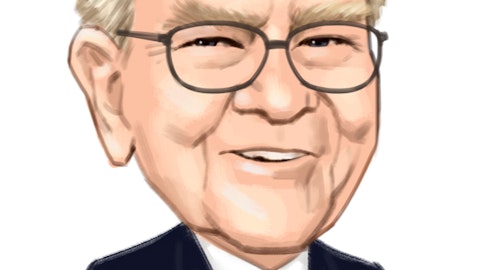Ken Usdin: So it’s a little — so is it straight line or is it a little bit front load, like, I just want to get — is just a straight line divided by or it has a little bit of like a tail?
Alastair Borthwick: No, it’s got a little more in 2025 than 2026.
Ken Usdin: Okay, I got it. Thank you. And just one question. Can you just remind us of brokerage fees this quarter felt the impact, I think you said it of the soft averages from this quarter. And so I think should we expect to see just from the markets bounce that we saw in the fourth quarter, that to play well into the first quarter starting points from the management fees perspective?
Alastair Borthwick: Yeah. I think you should expect our global markets performance to continue right now. I mean, obviously, there’s a pretty constructive environment for the markets business at this point. I don’t think anything has changed there. There’s a lot of client repositioning going on. So, yeah, I think the fourth quarter is sort of the right number to start with. And then you’ve just got to, I think, adjust for the fact that obviously, you’ve got a step up in their activity in Q1. If you — I don’t know if I misinterpreted, if you’re talking about the wealth management.
Ken Usdin: Yes.
Alastair Borthwick: Then those fees are obviously just going to work on the monthly lag based on where the markets go over time. So obviously the markets are elevated right now, and that should [pretend] (ph) well, for the future.
Ken Usdin: That’s what I was getting at. Thank you. Right. Just confirming that we didn’t see the benefit yet. That comes further based on the averages and how that’ll play forward, presuming the market hangs in there.
Alastair Borthwick: Correct. That tends to be a lag by a month or so. So you’ll see that in Q1.
Ken Usdin: Okay, got it. Thank you.
Operator: We’ll take our next question from Ryan Kenny of Morgan Stanley.
Ryan Kenny: Hi. Thanks for taking my question. Just following up on a few questions ago on the commercial credit side. So the commercial net charge-offs did roughly double sequentially. And you mentioned that there were a few customers that popped up. Should we interpret that to mean that the pace of deterioration decelerates and it was just a one-off, or is there anything else going on under the hood there?
Alastair Borthwick: Yeah, so I don’t think — let me put it this way, I think it’s too early to conclude that it’s anything other than just a momentary spike-up. But if you look at that chart, essentially what’s going on is two things. First, we’ve got a little bit of office, and that’s going to bounce around over the course of time. It just takes a while to resolve that portfolio. It’s pretty small for us, obviously. We feel like we’re doing all the right things with it, but that was a little elevated this quarter relative to the prior three. And then more broadly in commercial, there were a couple of other things that took place this quarter. Again, we were pretty fully reserved against them. So we sort of saw those coming.
Asset quality generally in commercial remains in a very, very good place outside of the office sector. And you can again see that in terms of — look at our reserve will criticize that declined this quarter. So I don’t think there’s any change there. The issue is just that we’re starting with such small numbers in commercial that anything appears like a spike.
Ryan Kenny: Thanks. And then just one more clarifying question on NII. So in this scenario with the six rate cuts, can you help us understand how you expect the deposit mix to migrate? And specifically, would the migration from NIP to IP deposits grind to a halt? Or is there any scenario where NIP deposits actually start growing again?
Alastair Borthwick: Well, I think what we’re trying to describe is a sense that we’re getting towards the tail end of this now, partly because we’re now six months away from the last time that the fed raised rates, and then partly because if we do have rate cuts, it’s going to start to disincent people moving out of non-interest bearing. So. that’s what we’re describing over the course of time. We’ve got to see how that develops through the course of the year.
Ryan Kenny: Thanks.
Operator: We’ll take our final question from Gerard Cassidy of RBC.
Gerard Cassidy: Hi, Brian. Hi, Alistair. You guys have obviously done a very good job in the consumer banking area with digital banking, and I frame that for you guys in this question. We hear a lot about AI and what it could do for the banking industry. And when you look out over the next three to five years and you invest in AI to improve efficiencies, could it have a similar impact what digital banking did for consumer banking pre-iPhone to where we are today in your business? Or is it going to be more like blockchain, where it was a lot of discussion about the future of blockchain, but we don’t hear much about that anymore? Do you guys have a view on what AI could be for your business over the next three to five years?
Brian Moynihan: I’m not — I agree with you. I’m not sure that there’s a relevant comparison to blockchain, but let’s just focus on AI. If you look at ’21, you can see the digital movement. One of the things in the digital movement you see is Erica in the lower left-hand page — lower left-hand chart on Page 21, Gerard, and you can see that in the fourth quarter, the 170 million interactions with Erica, where people effectively answered on question another 2 million people from last year to this year using it on a basis, 16 million up to 18 million people using it, unique users. And that’s just an example. And that’s AI in an early stage. We built that starting ten years ago. It operates on our data, use natural language processing.





